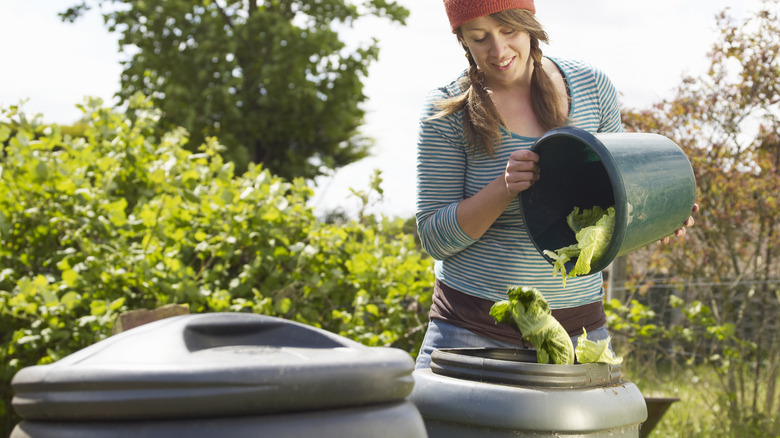Martha Stewart's Do's And Don'ts To Starting A Compost Bin For Beginners
We may receive a commission on purchases made from links.
If you've never made your own compost and the whole process sounds a bit daunting, don't be discouraged. Once you realize how easy it is, you'll wonder why you didn't get started sooner. Not only will composting at home result in less food and yard waste, but it should also help you have healthier and happier gardens. Martha Stewart not only regularly uses compost herself, but also has an entire YouTube video of helpful recommendations for those who are just starting on their composting journey.
It's important to choose the right bin for your compost. Either a standing bin that has a tight fitting lid, like the type Stewart uses, or a rotating tumbler are ideal. With the first option, try to pick one that has an opening lower on the bin, so you can harvest the ready-made compost while you continue to add materials to the top. But if you prefer the second option, get one with dual chambers. That way, you can let the full side decompose while you add waste to the second chamber. Miracle-Gro's dual chamber compost tumbler is a great example of this style.
As Stewart notes, the food scraps and other common compost "ingredients" can generally be categorized as either green materials, which add nitrogen, or brown materials, which contribute carbon. This mix is important because it creates the balance necessary to feed the microbes that break down everything in your compost. Try to layer the greens and browns evenly, as this will help speed up the decomposition process. While there are many materials in your kitchen and yard that are perfect for adding to your bin, there are also some items that backyard composters should avoid.
What you can add to your compost bin
As Martha Stewart shows, much of your yard and kitchen debris can go into your compost bin. This includes green materials like vegetable scraps from your kitchen, leftover grass clippings, spent flowers, crushed egg shells, and even coffee grounds. Waste from your yard and garden such as dried leaves, small shrub trimmings, and pine needles are also perfect for adding to compost, and are regarded as brown materials. Papers and cardboard are also great as brown waste, but make sure you tear them into small pieces first, and avoid anything with a plastic coating. As Stewart notes, you should always try and chop everything up before putting it into the compost, so it will break down faster.
While there are many things that can go into your compost, that doesn't mean you can just throw in anything. You shouldn't put any type of meat products, including bones in your backyard compost bin, because these often create an odor, and might attract vermin and other pests. You also don't want to put animal products like dairy and cheese into your bin. Fatty foods such as French fries should also be avoided. Above all, unless your pets are chickens or worms, never add pet waste to your compost. A backyard composting bin doesn't generally get hot enough to kill all of the harmful pathogens that these materials could generate as they decompose. If you follow these guidelines, after just a few months you should end up with healthy, dark humus-heavy compost that will enrich the soil in your garden beds.
